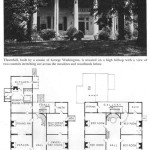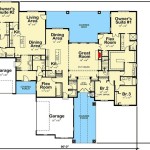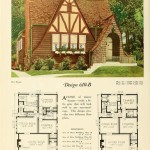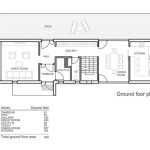Concrete slab house plans outline the design and construction of houses built using a concrete slab foundation. This type of foundation consists of a thick, continuous layer of concrete poured directly onto a prepared subgrade, providing a stable and durable base for the house.
Concrete slab houses are popular due to their versatility and cost-effectiveness. They can be built in various shapes and sizes, making them suitable for different architectural styles and land configurations. Additionally, concrete slabs are relatively easy to install, as they do not require extensive excavation or the construction of a conventional foundation system.
In this article, we will delve into the key aspects and considerations for designing and constructing concrete slab houses. We will explore the various types of concrete slabs, design considerations, construction methods, and best practices to ensure the durability and comfort of these homes.
When designing and constructing concrete slab houses, it is essential to consider the following key points:
- Foundation Type
- Soil Conditions
- Insulation
- Drainage
- Expansion Joints
- Reinforcement
- Curing
- Moisture Control
- Cost
By carefully considering these aspects, you can ensure the durability, comfort, and energy efficiency of your concrete slab house.
Foundation Type
The type of foundation used in a concrete slab house is crucial for its structural integrity and durability. Concrete slabs can be supported by different foundation systems, each with its own advantages and considerations.
Monolithic Slab
A monolithic slab is a single, continuous concrete slab that extends throughout the entire footprint of the house. It is poured directly onto a prepared subgrade and acts as both the foundation and the floor of the house. Monolithic slabs are relatively simple to construct and cost-effective, making them a popular choice for many concrete slab houses.
Raised Slab
A raised slab is a concrete slab that is elevated above the ground level on a perimeter foundation or crawlspace. This type of foundation provides additional protection from moisture and pests, making it suitable for areas with high water tables or poor drainage. Raised slabs also allow for easier access to utilities and mechanical systems, which can be installed in the crawlspace below the slab.
Post-Tension Slab
A post-tension slab is a concrete slab that is reinforced with high-strength steel cables or tendons. These cables are tensioned after the concrete has been poured, creating a compressive force that increases the strength and durability of the slab. Post-tension slabs are typically used for larger or more complex concrete slab houses, as they can span longer distances and support heavier loads.
Waffle Slab
A waffle slab is a concrete slab that is formed using a grid of deep ribs or beams. These ribs create a waffle-like pattern on the underside of the slab, which provides additional strength and reduces the amount of concrete required. Waffle slabs are often used in commercial and industrial buildings, but they can also be used in residential concrete slab houses.
The choice of foundation type for a concrete slab house depends on various factors, including the soil conditions, the size and complexity of the house, and the budget. It is important to consult with a qualified structural engineer to determine the most appropriate foundation type for your specific project.
Soil Conditions
The soil conditions at the building site play a significant role in the design and construction of concrete slab houses. Different soil types have varying characteristics that can affect the stability, drainage, and overall performance of the concrete slab.
- Expansive Soils
Expansive soils are soils that expand and contract significantly with changes in moisture content. When these soils dry out, they shrink and can cause the concrete slab to crack or heave. To mitigate this issue, special measures need to be taken, such as using expansive soil additives or reinforcing the concrete slab with steel fibers. - Compressible Soils
Compressible soils are soils that can compact or settle under the weight of the concrete slab. This settlement can lead to uneven floors and structural damage. To prevent this, the soil must be properly compacted before the concrete slab is poured, or the slab must be reinforced with additional steel to resist the settlement. - Poorly Drained Soils
Poorly drained soils are soils that do not allow water to drain away easily. This can lead to water accumulation under the concrete slab, which can cause moisture problems and damage to the slab. To address this issue, a proper drainage system must be installed to divert water away from the foundation. - High Water Table
A high water table can also pose challenges for concrete slab houses. If the water table is too high, it can cause the soil to become saturated and lose its bearing capacity. This can lead to the concrete slab sinking or cracking. To prevent this, the foundation must be designed to withstand the hydrostatic pressure of the water table.
A geotechnical engineer can evaluate the soil conditions at the building site and provide recommendations for the appropriate foundation type and design considerations to ensure the stability and durability of the concrete slab house.
Insulation
Insulation is crucial in concrete slab houses to maintain a comfortable indoor temperature, reduce energy consumption, and prevent moisture problems. Concrete has a high thermal mass, which means it absorbs and releases heat slowly. This can lead to temperature fluctuations inside the house, making it uncomfortable and energy inefficient. Insulation helps to mitigate these fluctuations by reducing heat transfer through the concrete slab.
There are two main types of insulation used in concrete slab houses: rigid insulation and reflective insulation. Rigid insulation is typically made from polystyrene, polyurethane, or fiberglass and is placed directly under the concrete slab. Reflective insulation is made from a thin layer of aluminum or other reflective material and is placed on top of the concrete slab.
The type and thickness of insulation required for a concrete slab house depends on the climate zone, the size and layout of the house, and the desired level of energy efficiency. In colder climates, thicker insulation is generally required to prevent heat loss through the concrete slab. In warmer climates, insulation can help to reduce heat gain and keep the house cooler.
Proper installation of insulation is essential to ensure its effectiveness. Rigid insulation should be installed in a continuous layer under the concrete slab, without any gaps or voids. Reflective insulation should be installed with the reflective side facing up, and all seams should be taped to prevent air leaks.
Insulating the concrete slab can significantly improve the comfort, energy efficiency, and durability of a concrete slab house. By reducing heat transfer through the slab, insulation helps to maintain a stable indoor temperature, reduce energy consumption, and prevent moisture problems.
Drainage
Proper drainage is essential for concrete slab houses to prevent water accumulation and moisture problems that can damage the slab and the structure of the house. A well-designed drainage system helps to divert water away from the foundation and prevents the soil from becoming saturated, which can lead to settlement and cracking of the concrete slab.
- Grading
Proper grading of the land around the house is crucial for effective drainage. The ground should be sloped away from the foundation in all directions, with a minimum slope of 1/4 inch per foot. This slope helps to direct water away from the house and prevent it from pooling around the foundation. - Gutters and Downspouts
Gutters and downspouts are essential for collecting rainwater from the roof and directing it away from the foundation. Gutters should be installed along the entire perimeter of the roof, and downspouts should be extended at least 4 feet away from the foundation. Splash blocks or drainpipes can be used to further extend the flow of water away from the house. - French Drains
French drains are perforated pipes that are installed underground to collect and drain excess water from the soil. They are typically installed around the perimeter of the foundation and are connected to a sump pump or drainage ditch. French drains help to lower the water table around the foundation and prevent water from seeping into the basement or crawlspace. - Sump Pumps
Sump pumps are used to remove water that collects in the basement or crawlspace. They are typically installed in a sump basin, which is a pit dug below the floor level. When the water level in the sump basin rises, the sump pump activates and pumps the water out of the basement or crawlspace.
By implementing these drainage measures, you can help to protect your concrete slab house from water damage and ensure its longevity.
Expansion Joints
Expansion joints are an essential component of concrete slab houses to prevent cracking and damage caused by thermal expansion and contraction. Concrete expands and contracts with changes in temperature, and the use of expansion joints allows the slab to move without causing stress or strain that could lead to cracking. Expansion joints are typically installed in concrete slabs that are larger than 8 feet by 8 feet or that are subject to significant temperature fluctuations.
- Control Joints
Control joints are shallow grooves or cuts made in the concrete slab to create a weakened plane where the slab is intended to crack. They are typically spaced 8 to 12 feet apart and are installed in a straight line to control the location and direction of cracking. Control joints help to prevent random cracks from forming in the slab and can also be used to create decorative patterns. - Isolation Joints
Isolation joints are complete separations between two concrete slabs or between a concrete slab and another structure, such as a wall or column. They are used to prevent the transfer of forces between different parts of the structure and to allow for independent movement. Isolation joints are typically installed around the perimeter of the concrete slab and at any points where the slab abuts another structure. - Construction Joints
Construction joints are joints that are created when a concrete slab is poured in multiple sections. They are typically located at the end of each day’s pour and are designed to allow for the concrete to cure and shrink without causing stress on the adjacent concrete. Construction joints are typically sealed with a flexible sealant to prevent water and moisture from penetrating the joint. - Expansion Gap
An expansion gap is a space left between a concrete slab and an adjacent structure, such as a wall or foundation. The gap allows the concrete slab to expand and contract without coming into contact with the adjacent structure, which could cause damage. Expansion gaps are typically filled with a compressible material, such as foam or cork, to prevent debris from entering the gap.
Properly designed and installed expansion joints are essential for the long-term performance and durability of concrete slab houses. By allowing the concrete slab to move freely with temperature changes, expansion joints help to prevent cracking, damage, and premature deterioration.
Reinforcement
Reinforcement is a crucial aspect of concrete slab house plans to enhance the strength and durability of the concrete slab. Concrete is strong in compression but weak in tension, and reinforcement helps to resist tensile forces and prevent cracking. Different types of reinforcement can be used in concrete slabs, depending on the specific requirements of the project.
Steel Reinforcement
Steel reinforcement is the most common type of reinforcement used in concrete slabs. It consists of steel bars or mesh that are placed within the concrete slab to provide additional tensile strength. Steel reinforcement can be used to reinforce the entire slab or to reinforce specific areas, such as around openings or at the edges of the slab. The size, spacing, and placement of the steel reinforcement should be carefully calculated by a structural engineer to ensure adequate strength and durability.
Fiber Reinforcement
Fiber reinforcement involves adding small fibers to the concrete mix to improve its tensile strength and toughness. Fibers can be made from a variety of materials, such as steel, glass, or polypropylene. When the concrete is subjected to tensile forces, the fibers bridge the cracks and prevent them from propagating. Fiber reinforcement can be used in addition to steel reinforcement or as a standalone reinforcement solution.
Post-Tensioning
Post-tensioning is a method of reinforcing concrete slabs by applying a compressive force to the concrete after it has been poured and cured. This compressive force is created by tensioning high-strength steel cables or tendons that are placed within the concrete slab. Post-tensioning increases the strength and stiffness of the concrete slab and reduces the likelihood of cracking. Post-tensioning is typically used in larger or more complex concrete slab houses.
Proper reinforcement of concrete slabs is essential to ensure their long-term performance and durability. By carefully considering the type, size, and placement of reinforcement, engineers can design concrete slab houses that are strong, durable, and resistant to cracking.
Curing
Curing is a critical process in concrete slab house plans that ensures the concrete achieves its full strength and durability. Proper curing involves maintaining the proper moisture and temperature conditions for the concrete to hydrate and gain strength. Inadequate curing can lead to cracking, reduced strength, and other problems that can affect the performance and longevity of the concrete slab house.
Initial Curing
Initial curing begins immediately after the concrete has been placed and finished. The goal of initial curing is to prevent the concrete from drying out too quickly, which can lead to cracking. The concrete surface is typically covered with a curing compound, plastic sheeting, or wet burlap to retain moisture. Initial curing should be maintained for at least 7 days, but longer curing periods may be required in hot or dry climates.
Moist Curing
Moist curing involves keeping the concrete slab moist throughout the curing period. This can be achieved by spraying the concrete with water, covering it with wet burlap or mats, or using a fogging system. Moist curing helps to ensure that the concrete hydrates properly and achieves its full strength. Moist curing should be maintained for at least 28 days, but longer curing periods may be beneficial for thicker slabs or in cold climates.
Temperature Control
Temperature control is also important during the curing process. Extreme temperatures can affect the hydration process and the strength development of the concrete. In cold weather, the concrete should be protected from freezing temperatures by using insulating blankets or heaters. In hot weather, the concrete should be shaded from direct sunlight and kept moist to prevent it from drying out too quickly.
Monitoring and Testing
Monitoring and testing are essential to ensure proper curing of the concrete slab. The concrete temperature and moisture content should be monitored regularly to ensure that they are within the desired range. Strength testing can also be performed to verify that the concrete has achieved the required strength before it is put into service.
Proper curing is essential for the long-term performance and durability of concrete slab houses. By carefully following the curing procedures and monitoring the concrete conditions, you can ensure that the concrete slab achieves its full strength and provides a solid foundation for your home.
Moisture Control
Moisture control is essential in concrete slab house plans to prevent moisture-related problems that can affect the durability, comfort, and health of the occupants. Concrete is a porous material that can absorb and retain moisture from the ground, air, and other sources. If not properly controlled, moisture can lead to a variety of problems, including mold growth, rot, and structural damage.
Vapor Barrier
A vapor barrier is a layer of material that is placed under the concrete slab to prevent moisture from migrating up from the ground. Vapor barriers are typically made from polyethylene sheeting or other moisture-resistant materials. They should be installed with a minimum overlap of 6 inches and all seams should be taped to ensure a continuous barrier.
Drainage Layer
A drainage layer is a layer of gravel or crushed stone that is placed under the vapor barrier to help drain away any moisture that may penetrate the vapor barrier. The drainage layer should be at least 4 inches thick and should be graded to drain away from the foundation.
Perimeter Drain
A perimeter drain is a perforated pipe that is installed around the perimeter of the foundation to collect and drain away any water that may accumulate around the foundation. The perimeter drain should be connected to a sump pump or other drainage system to remove the water from the site.
Interior Drainage
Interior drainage measures may also be necessary to control moisture in concrete slab houses. This may include installing a dehumidifier in the basement or crawlspace to remove excess moisture from the air, or installing a sump pump to remove any water that may accumulate in the basement or crawlspace.
By implementing these moisture control measures, you can help to prevent moisture-related problems in your concrete slab house and ensure a healthy and comfortable living environment.
Cost
The cost of concrete slab house plans varies depending on a number of factors, including the size and complexity of the house, the type of foundation used, the materials used, and the local labor rates. However, concrete slab houses are generally more affordable to build than houses with other types of foundations, such as basements or crawlspaces.
One of the main reasons why concrete slab houses are more affordable is that they do not require the excavation and construction of a basement or crawlspace. This can save a significant amount of time and money. Additionally, concrete slabs are relatively easy to install, which can also help to reduce labor costs.
The type of foundation used can also affect the cost of a concrete slab house. Monolithic slabs are the most affordable type of foundation, followed by raised slabs and post-tension slabs. Waffle slabs are the most expensive type of foundation, but they are also the strongest and most durable.
The materials used to construct the concrete slab can also affect the cost. Concrete slabs made with higher-strength concrete will be more expensive than slabs made with lower-strength concrete. Additionally, slabs that are reinforced with steel or fiber will be more expensive than unreinforced slabs.
Overall, concrete slab house plans are a cost-effective option for building a new home. By carefully considering the factors that affect the cost, you can design and build a concrete slab house that meets your needs and budget.

/cdn.vox-cdn.com/uploads/chorus_image/image/60259279/forrest_house_besonias_almeida_architecture_residential_argentina_holiday_home_concrete_dezeen_2364_col_3_1704x1136.0.jpg)








Related Posts








